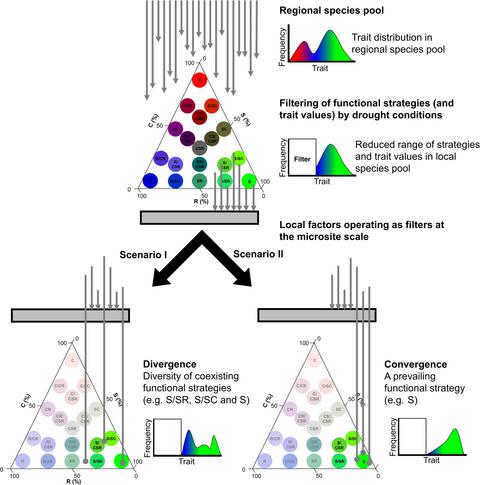Our official English website, www.x-mol.net, welcomes your
feedback! (Note: you will need to create a separate account there.)
Interactive effects of shading and disturbance on plant invasion in an arid shrubland: Assembly processes and CSR-strategies
Journal of Ecology ( IF 5.3 ) Pub Date : 2021-03-19 , DOI: 10.1111/1365-2745.13650 Víctor M. Escobedo 1 , Rodrigo S. Rios 2, 3 , Ernesto Gianoli 2, 4
中文翻译:

干旱灌丛中遮荫和干扰对植物入侵的交互影响:组装过程和 CSR 策略
更新日期:2021-03-19
Journal of Ecology ( IF 5.3 ) Pub Date : 2021-03-19 , DOI: 10.1111/1365-2745.13650 Víctor M. Escobedo 1 , Rodrigo S. Rios 2, 3 , Ernesto Gianoli 2, 4
Affiliation

|
- Disturbance by small mammals and shrub canopies are ecological factors typical of arid ecosystems that may influence plant invasion through environmental and community changes. Whereas disturbance beneath shrub canopies may promote invasion by removing dominant species, disturbance in open areas may hinder plant invasion by increasing environmental harshness. However, we are unaware of studies explicitly addressing the interactive effects of disturbance by mammals and shading by shrubs on community assembly processes to understand plant invasion. In an arid shrubland, disturbance and shading were caused by the fossorial rodent Spalacopus cyanus and the shrub Flourensia thurifera, respectively. We used functional dispersion data (trait convergence vs. divergence) and Grime´s theory (competitive, stress-tolerant and ruderal strategies, CSR) to gain insights into the underlying assembly processes.
- We compared environmental conditions, richness and abundance of native and exotic species, as well as functional dispersion and prevalence of CSR-strategies across four microsites (60 × 60 cm plots): undisturbed/open, undisturbed/shaded, disturbed/open and disturbed/shaded. We tested for functional differences between native and exotic species.
- Species richness was similar among microsites for both native and exotic species. Shading ameliorated environmental conditions, promoted trait divergence and increased prevalence of C- and R-strategies. Disturbance increased the abundance of exotic species and removed dominant species in shaded microsites. Exotic and native species were functionally different: exotics showed shorter life span, lower height, thinner stems and smaller leaves than natives.
- Synthesis. Disturbance, by removing plant biomass, favoured exotic species in shaded microsites, where shrub canopy ameliorated environmental conditions and—by relaxing habitat filtering—promoted niche partitioning processes as well as C- and R-strategies. We illustrate the value of linking trait-based ecology approaches to micro-environmental conditions, as it may provide insights into the underlying community processes when studying plant invasions at the local and microsite scales. Disturbed microsites beneath shrub canopies could be ‘hotspots’ where to concentrate efforts to manage plant invasions in arid ecosystems.
中文翻译:

干旱灌丛中遮荫和干扰对植物入侵的交互影响:组装过程和 CSR 策略
- 小型哺乳动物和灌木冠层的干扰是干旱生态系统的典型生态因素,可能通过环境和群落变化影响植物入侵。灌木冠层下的干扰可能会通过去除优势物种来促进入侵,而开放区域的干扰可能会通过增加环境恶劣程度来阻碍植物入侵。然而,我们不知道有研究明确解决哺乳动物干扰和灌木遮荫对群落组装过程的相互作用影响,以了解植物入侵。在干旱的灌木林中,扰动和阴影是由化石啮齿动物Salacopus cyanus和灌木Flourensia thurifera 引起的, 分别。我们使用功能分散数据(特征收敛与发散)和 Grime 的理论(竞争、耐压和粗鲁策略,CSR)来深入了解底层组装过程。
- 我们比较了环境条件、本地和外来物种的丰富度和丰度,以及 CSR 策略在四个微型站点(60 × 60 厘米地块)的功能分散和流行:未受干扰/开放、未受干扰/阴影、受干扰/开放和受干扰/阴影。我们测试了本地和外来物种之间的功能差异。
- 本地和外来物种的微型站点之间的物种丰富度相似。阴影改善了环境条件,促进了性状分化并增加了 C 和 R 策略的流行。干扰增加了外来物种的丰度,并去除了阴影微型站点中的优势物种。外来物种和本地物种在功能上是不同的:外来物种比本地物种寿命更短、高度更低、茎更细、叶子更小。
- 合成。通过去除植物生物量,干扰有利于阴凉微型地点中的外来物种,其中灌木冠层改善了环境条件,并且通过放松栖息地过滤促进了生态位划分过程以及 C 和 R 策略。我们说明了将基于特征的生态学方法与微环境条件联系起来的价值,因为它可以在研究局部和微型场地尺度的植物入侵时提供对潜在群落过程的见解。灌木冠层下受干扰的微型站点可能是“热点”,集中精力管理干旱生态系统中的植物入侵。











































 京公网安备 11010802027423号
京公网安备 11010802027423号